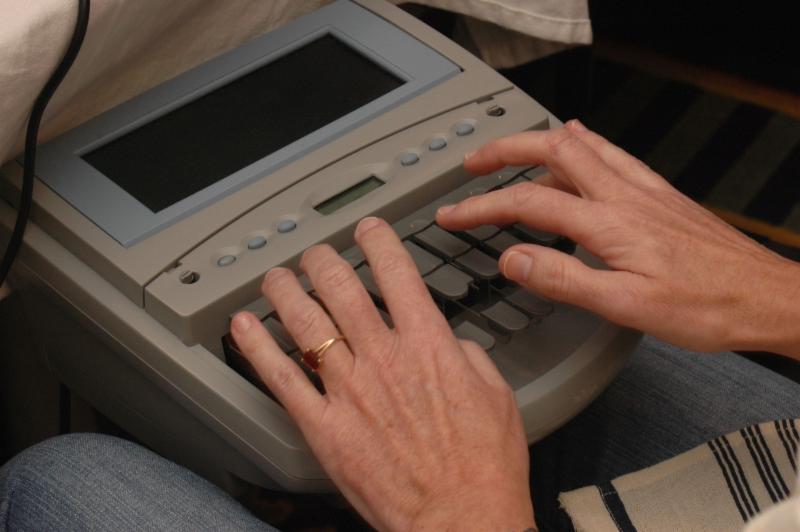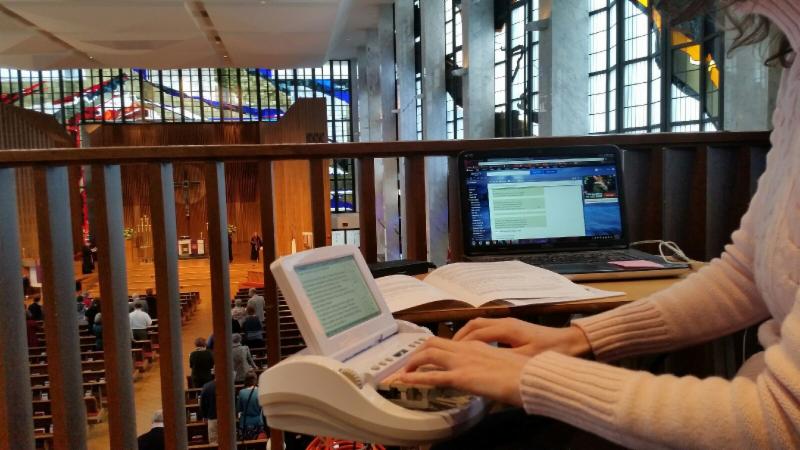Captioning
Up to 20 percent of the US population has a hearing loss, and the percentages grow higher with an aging audience. Hearing loss is one of the most common service-connected disabilities of returning veterans of the Gulf wars. A good sound system and assisted listening devices are not enough for persons with significant hearing loss. You might automatically think of hiring sign language interpreters to make your events more accessible to people who can't hear the proceedings. Consider captioning instead as a more globally useful accommodation, since only a fraction of people with hearing loss understand American Sign Language. Add sign language interpretation if someone requests it when they register, of course. For open community events both captioning and signing should be provided. You will find many people appreciate captioning, including some for whom English is not their first language.
A number of services, systems, and options are available to help you provide captions. Full service companies offer captioning in English and Spanish for individuals, small groups, or large events. They also can add captions to your media ahead of time. Even if your event is in a rural area, remote captioning services can be provided using a voice and internet connection.

Steno machine used for captioning — photo courtesy of Dallas Captioning
These firms employ highly trained captioners who use steno machines, the same devices uses by court recorders to capture the proceedings verbatim. This system is called CART, which stands for Communication Access Realtime Translation.
Unfortunately not every event or meeting has the budget to hire CART operators. Less effective, but still better than not providing any visual accommodations, are the following systems:
- Computer Assisted Note-taking (CAN) relies on volunteers who are skilled typists and keep up the best they can with the presenters. Typist can use the auto-correct feature to designate certain keystrokes to generate whole words or phrases as one way to improve their speed. People relying on CAN captioning need to be patient and ready to accept a significantly higher error rate than with CART.
- Voice recognition dictation systems, while promising, have yet to be perfected. Watch a YouTube video with the automatic captions turned on if you need to be convinced of the continued high error rate and grave mistakes made. But if one person uses the voice recognition equipment, takes the time to train the software to recognize his or her voice, builds a vocabulary in the software, and speaks distinctly into the microphone a fair version of what is said can be represented in captions.
- Pen and paper or computer note-taking may work for an individual who can understand most of the proceedings but not be able to take notes at the same time. Using a flip chart and having a volunteer record the main points also helps, as does using an outline on Power Point slides and sticking closely to the outline.

Captioner at Lovers Lane UMC, Dallas — photo courtesy of Dallas Captioning
When working with a captioner, the speed and accuracy can be dramatically improved if you provide an advance copy of the orders of worship, scripture readings, and transcripts of anything else that has been prepared ahead of time. Always submit lists of names ahead of time, such as clergy appointments or award recipients. Having the materials in advance allows the captioner to build the needed vocabulary based on the words you use, and also to scroll through liturgies, hymns, etc. at the exact time the words are being spoken.
Technology for captioning is improving constantly. Some providers can use encoders to add captions directly to the video feed so they are projected on the main screen. This system is easiest for the most viewers, as it does not require a person to sit in a separate section, or try to follow captions on a tablet or smart phone while watching a speaker at the same time.
Make it your standard to add captioning to all spoken media prior to the event. For instance any video report prepared for annual conference should have legible captions. You can hire a captioning company to do this, or do it yourself. Find links to YouTube videos offering step by step instructions for captioning (and much more information) on our Captioning Resources page. Doing the captioning yourself is not difficult, but it is time-consuming. Make sure there is ample contrast on the screen — white letters are difficult to read on light backgrounds. No matter what type of captioning you select, be assured that many of us will be grateful for the improved access to the event we are attending.
Adapted from The Voice, Lynn Swedberg, March 2016
 umdeaf@gmail.com
umdeaf@gmail.com


